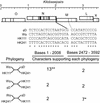Imbroglios of viral taxonomy: genetic exchange and failings of phenetic approaches
- PMID: 12169615
- PMCID: PMC135278
- DOI: 10.1128/JB.184.17.4891-4905.2002
Imbroglios of viral taxonomy: genetic exchange and failings of phenetic approaches
Abstract
The practice of classifying organisms into hierarchical groups originated with Aristotle and was codified into nearly immutable biological law by Linnaeus. The heart of taxonomy is the biological species, which forms the foundation for higher levels of classification. Whereas species have long been established among sexual eukaryotes, achieving a meaningful species concept for prokaryotes has been an onerous task and has proven exceedingly difficult for describing viruses and bacteriophages. Moreover, the assembly of viral "species" into higher-order taxonomic groupings has been even more tenuous, since these groupings were based initially on limited numbers of morphological features and more recently on overall genomic similarities. The wealth of nucleotide sequence information that catalyzed a revolution in the taxonomy of free-living organisms necessitates a reevaluation of the concept of viral species, genera, families, and higher levels of classification. Just as microbiologists discarded dubious morphological traits in favor of more accurate molecular yardsticks of evolutionary change, virologists can gain new insight into viral evolution through the rigorous analyses afforded by the molecular phylogenetics of viral genes. For bacteriophages, such dissections of genomic sequences reveal fundamental flaws in the Linnaean paradigm that necessitate a new view of viral evolution, classification, and taxonomy.
Figures





Similar articles
-
Amino acid sequence associated with bacteriophage recombination site helps to reveal genes potentially acquired through horizontal gene transfer.BMC Bioinformatics. 2020 Jul 24;21(Suppl 12):305. doi: 10.1186/s12859-020-03599-y. BMC Bioinformatics. 2020. PMID: 32703190 Free PMC article.
-
Reticulate representation of evolutionary and functional relationships between phage genomes.Mol Biol Evol. 2008 Apr;25(4):762-77. doi: 10.1093/molbev/msn023. Epub 2008 Jan 29. Mol Biol Evol. 2008. PMID: 18234706
-
Molecular phylogenetics: testing evolutionary hypotheses.Methods Mol Biol. 2009;502:131-68. doi: 10.1007/978-1-60327-565-1_9. Methods Mol Biol. 2009. PMID: 19082555
-
Phage diversity, genomics and phylogeny.Nat Rev Microbiol. 2020 Mar;18(3):125-138. doi: 10.1038/s41579-019-0311-5. Epub 2020 Feb 3. Nat Rev Microbiol. 2020. PMID: 32015529 Review.
-
Genetic recombinational events in prokaryotes and their viruses: insight into the study of evolution and biodiversity.Antonie Van Leeuwenhoek. 2017 Dec;110(12):1493-1514. doi: 10.1007/s10482-017-0916-5. Epub 2017 Jul 26. Antonie Van Leeuwenhoek. 2017. PMID: 28748289 Review.
Cited by
-
Complete genomic sequence of the virulent Salmonella bacteriophage SP6.J Bacteriol. 2004 Apr;186(7):1933-44. doi: 10.1128/JB.186.7.1933-1944.2004. J Bacteriol. 2004. PMID: 15028677 Free PMC article.
-
Hot new virus, deep connections.Proc Natl Acad Sci U S A. 2004 May 18;101(20):7495-6. doi: 10.1073/pnas.0402151101. Epub 2004 May 11. Proc Natl Acad Sci U S A. 2004. PMID: 15138303 Free PMC article. No abstract available.
-
Comparisons of two large phaeoviral genomes and evolutionary implications.J Mol Evol. 2003 Dec;57(6):613-22. doi: 10.1007/s00239-003-2501-y. J Mol Evol. 2003. PMID: 14745530
-
Information theory based T7-like promoter models: classification of bacteriophages and differential evolution of promoters and their polymerases.Nucleic Acids Res. 2005 Oct 31;33(19):6172-87. doi: 10.1093/nar/gki915. Print 2005. Nucleic Acids Res. 2005. PMID: 16260472 Free PMC article.
-
Genomic organization and molecular analysis of virulent bacteriophage 2972 infecting an exopolysaccharide-producing Streptococcus thermophilus strain.Appl Environ Microbiol. 2005 Jul;71(7):4057-68. doi: 10.1128/AEM.71.7.4057-4068.2005. Appl Environ Microbiol. 2005. PMID: 16000821 Free PMC article.
References
-
- Ackermann, H. W., and H. M. Krisch. 1997. A catalogue of T4-type bacteriophages. Arch. Virol. 142:2329-2345. - PubMed
-
- Alejska, M., A. Kurzyniska-Kokorniak, M. Broda, R. Kierzek, and M. Figlerowicz. 2001. How RNA viruses exchange their genetic material. Acta Biochim. 48:391-407. - PubMed
-
- Altschul, S. F., W. Gish, W. Miller, E. W. Myers, and D. J. Lipman. 1990. Basic local alignment search tool. J. Mol. Biol. 215:403-410. - PubMed
Publication types
MeSH terms
Grants and funding
LinkOut - more resources
Full Text Sources
Other Literature Sources

